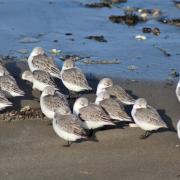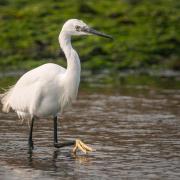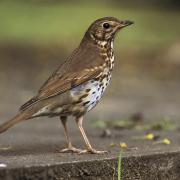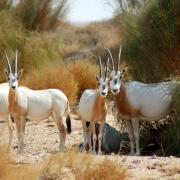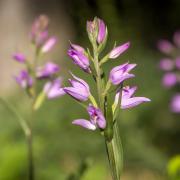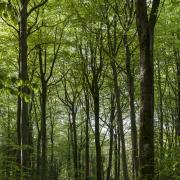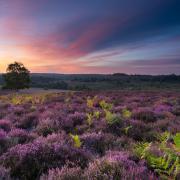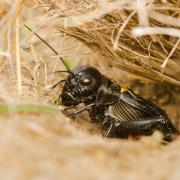Discover why the county's wild mammals are so important to their habitats with this month's news from the Hampshire and Isle of Wight Wildlife Trust.
The Hampshire & Isle of Wight Wildlife Trust has helped save and protect our otters, brent geese, southern damselfies, great crested newts and nationally scarce seagrass. And, thanks to smart management, other species have benefited too.
Readers of wildlife news and reports over the years will note phrases such as ‘threatened’, ‘recovering’ and even ‘extinct’ used regularly to highlight the mixed fortunes of our local wildlife. They will also note the frequent appearance of a handful of species that we seem to have a love affair with: the brent goose, dormouse, red squirrel, otter, water vole, seagrass… But why do we focus on certain species? Why are they featured so regularly? The answer lies in their deep connection with the Wildlife Trust’s work.
Attractive and charismatic, the mammals of Hampshire and the Isle of Wight have graced many a magazine cover. Naturally they get the popular vote but, importantly, they also give us vital information about the health and the quality of our ecosystems.
Take otters and water voles, for example. Healthy populations of these animals are a good indicator of how our river environments are doing. Otters were facing widespread persecution at the time that the Wildlife Trust was founded 50 years ago, but now, thanks in no small part to the work co-ordinated by the Trust’s Otters and Rivers Project, they are widespread in Hampshire. Water voles, previously harmed by river engineering practices and the release of the American mink, are now beginning to recover along our rivers. The Trust has made countless visits to landowners with these species in mind and the result is that many other species will have benefited from the advice we have given.
Protection for species like bats, great crested, newts, reptiles and dormice was revolutionised through the 1981 Wildlife & Countryside Act, but locally their champions have been the Wildlife Trust and our ‘species groups’ of volunteer naturalists. Other species that have merited special attention because of their local importance are the various birds living near to the Solent. Through our surveys and habitat work, we have helped support vulnerable populations of brent goose, dunlin and black-tailed godwit amongst others.
Over the last couple of decades, efforts to conserve our local rare species have been greatly boosted by the Species Recovery Programme and the Biodiversity Action Plan. These initiatives have their origins nationally, but the Wildlife Trust has been very active locally in converting aspirations into action. Through targeted surveys we have found out how some pretty unusual species are faring such as the medicinal leech, the nail fungus, the southern damselfly and the red-tipped cudweed. Through this work the Trust and its partners have focused their conservation efforts more effectively.
Our ‘living landscapes’ approach is the best way forward, says Dr David Rumble, Head of Conservation at the Wildlife Trust. Over the years, the Trust’s work has helped slow the decline – or better still, enabled the recovery – of many species in our two counties. But the ecology of our wildlife is often very complex, and in some cases populations may dwindle or vanish despite our very best efforts.
In the face of climate change we will almost certainly lose some species, and gain others, as plant and animal populations shift around in response to the changing conditions. A familiar maxim for conservationists is ‘Get the habitat right and the species will look after themselves’ or words to that effect. It seems certain that our ‘living landscapes’ approach to conservation is well placed to help us achieve this, and to give our wildlife the very best chance of survival as it adapts to a changing climate.
There will always be a need for research and protection of particular species, whether they are the appealing ‘flagship’ species that help us win public support, the species whose success we measure to understand the health of the wider environment, or the rarities that are hanging on at the brink of extinction.
Wild news
In 2011, Hampshire & Isle of Wight Wildlife Trust is celebrating its 50th anniversary and we recognise that wildlife is still under threat, perhaps more so than at any time in our history. If local wildlife is to survive and flourish for the next 50 years and beyond, we must create bigger, better, joined-up havens for wildlife, stretching right across our county.
To meet these challenges, we have developed our vision of ‘living landscapes’ which are all about the bigger picture. They’re about seeing our nature reserves as the beating heart of the wider landscape in which they lie. They’re about working with land-owners and communities to help wildlife thrive across the entire landscape. But we need your help, and the Wildlife Trust’s Living Landscape Appeal is your chance to create a better future for Hampshire’s wildlife. Every gift counts – big or small – and don’t forget that Gift Aid makes your donation go even further.
For full details of the Appeal, and how you can help, please see our website www.hwt.org.uk





